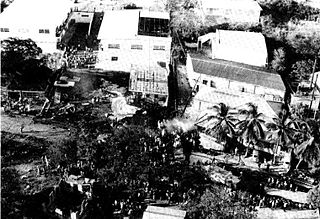
Westchester County Airport is a county-owned airport in Westchester County, New York, three miles (6 km) northeast of downtown White Plains, with territory in the towns of North Castle and Harrison, New York, and village of Rye Brook, New York. It is sometimes referred to as the White Plains Airport and is so identified by the Official Airline Guide (OAG).

Allegheny Airlines was a local service carrier that operated out of Pittsburgh, Pennsylvania, from 1952 to 1979, with routes primarily located in the eastern U.S. It was the forerunner of USAir that was subsequently renamed US Airways, which itself merged with American Airlines. Its headquarters were at Washington National Airport in Arlington County, Virginia.

American Airlines Flight 625, a Boeing 727-100, crashed at St. Thomas, U.S. Virgin Islands on April 27, 1976, while on a domestic scheduled passenger flight originating at T. F. Green Airport in Rhode Island and ending at Saint Thomas, United States Virgin Islands, with an intermediate stop at John F. Kennedy International Airport. 37 out of the 88 passengers on board died in the accident.

Air Tahoma was an American cargo airline based in Columbus, Ohio, United States. It was established and started operations in 1996 in San Diego then later moved to Indianapolis in 1998 and to its last location at Rickenbacker International Airport, Columbus. Air Tahoma operated contract cargo flights internationally to the Caribbean, Mexico, Vietnam, Philippines, and the United States. Air Tahoma ceased operations in 2009.

Southwest Airlines Flight 1248 was a scheduled passenger flight from Baltimore, Maryland, to Chicago, Illinois, continuing on to Salt Lake City, Utah, and then to Las Vegas, Nevada. On December 8, 2005, the airplane slid off a runway at Chicago-Midway while landing in a snowstorm and crashed into automobile traffic, killing a six-year-old boy.

American Airlines Flight 1572 was a flight from Chicago O'Hare International Airport to Bradley International Airport on November 12, 1995. The McDonnell Douglas MD-83 struck trees and an instrument landing system (ILS) antenna during landing, causing $9 million in damage to the aircraft.

American Airlines Flight 383 was a nonstop flight from New York City to Cincinnati on November 8, 1965. The aircraft was a Boeing 727, with 57 passengers, and 5 crew on board. The aircraft crashed on final approach to the Cincinnati/Northern Kentucky International Airport located in Hebron, Kentucky, United States. Only three passengers and one flight attendant survived the crash.

Air Tahoma Flight 185 was a scheduled cargo flight from Memphis to Cincinnati/Northern Kentucky International Airport conducted by Air Tahoma as part of a contract to freight parcels for courier firm DHL. On August 13, 2004, the flight crashed during approach to landing just one mile short of the runway. The Convair 580, which is a twin engine turboprop, was destroyed upon impact. The first officer was killed and the captain received minor injuries.

In an internal combustion engine, fuel starvation is the failure of the fuel system to supply sufficient fuel to allow the engine to run properly, for example due to blockage, vapor lock, contamination by water, malfunction of the fuel pump or incorrect operation, leading to loss of power or engine stoppage. There is still fuel in the tank(s), but it is unable to get to the engine(s) in sufficient quantity. By contrast, fuel exhaustion is an occurrence in which the vehicle in question becomes completely devoid of usable fuel, with results similar to those of fuel starvation.

TWA Flight 128 was a regularly scheduled Trans World Airlines passenger flight from Los Angeles to Boston, with intermediate stops in Cincinnati and Pittsburgh. On November 20, 1967, Flight 128 crashed on final approach to Greater Cincinnati Airport; 70 of the 82 people aboard the Convair 880 were killed in the tragic crash.

Mohawk Airlines Flight 411, a Fairchild FH-227B twin-engine turboprop, registered N7811M, was a scheduled domestic passenger service operated by Mohawk Airlines, between Albany and Glens Falls, New York. On November 19, 1969, it crashed into Pilot Knob Mountain, killing all 14 passengers and crew on board.

North Central Airlines was a local service carrier, a scheduled airline in the Midwestern United States. Founded as Wisconsin Central Airlines in 1944 in Clintonville, Wisconsin, the company moved to Madison in 1947. This is also when the "Herman the duck" logo was born on Wisconsin Central's first Lockheed Electra 10A, NC14262, in 1948. North Central's headquarters were moved to Minneapolis–St. Paul in 1952.

On 22 December 2009, an American Airlines Boeing 737-800, operating American Airlines Flight 331 and carrying 148 passengers and six crew, overran runway 12 on landing at Kingston in poor weather. The plane continued on the ground outside the airport perimeter and broke apart on the beach, causing injuries.

Allegheny Airlines Flight 485 was a regularly scheduled domestic passenger flight between Washington, D.C. and Newport News, Virginia, United States, with three stop-overs, two in Connecticut and a third in Pennsylvania. On June 7, 1971, the Allegheny Airlines Convair CV-580 operating the flight crashed on approach to Tweed New Haven Regional Airport, New Haven County, Connecticut.

On December 27, 1968, North Central Airlines Flight 458 crashed into a hangar while attempting a night landing in poor weather at O'Hare International Airport in Chicago, Illinois, in the United States. Of the 41 passengers and four crew members, only 17 passengers and one crew member survived. One person was killed and six were injured on the ground.

On December 20, 1972, North Central Airlines Flight 575 and Delta Air Lines Flight 954 collided on a runway at O'Hare International Airport in Chicago, Illinois, in the United States. Ten people died – all on the North Central aircraft – and 17 were injured in the accident. This was the second major airliner accident to happen in Chicago in December 1972; the other was United Airlines Flight 553, which crashed twelve days earlier on approach to Midway Airport.

Allegheny Airlines Flight 736 was a regularly scheduled flight that crashed while attempting to land at Bradford Regional Airport in Bradford, Pennsylvania, on December 24, 1968. Of the 47 occupants on board, 20 were killed.

















